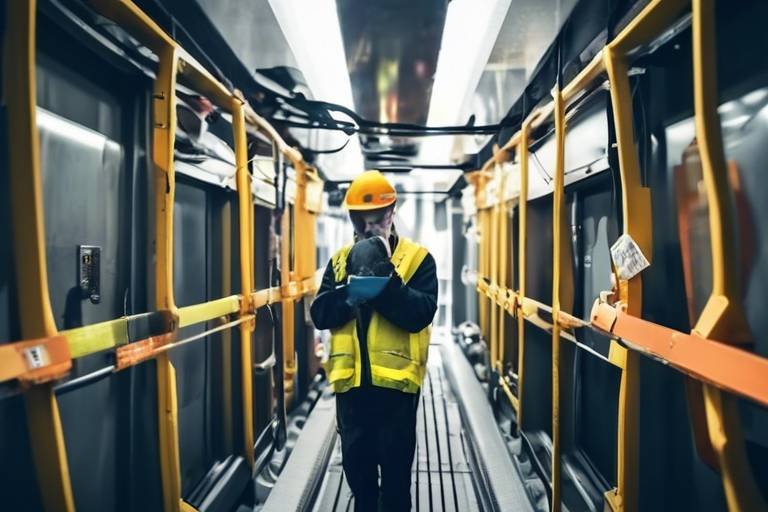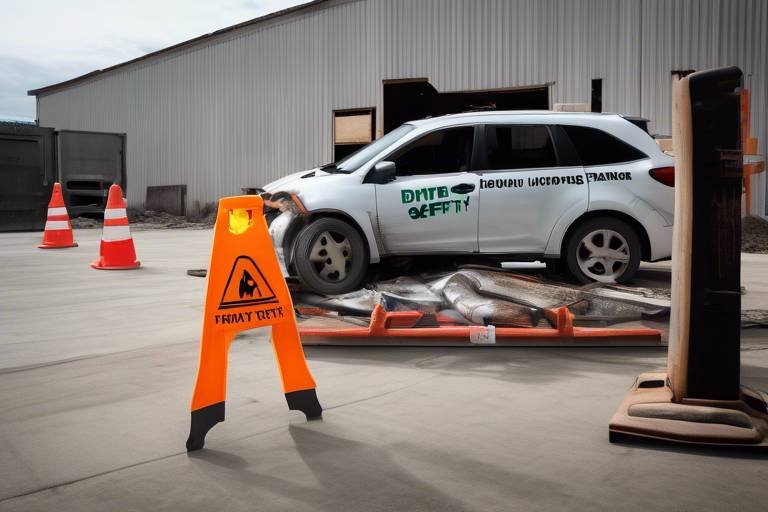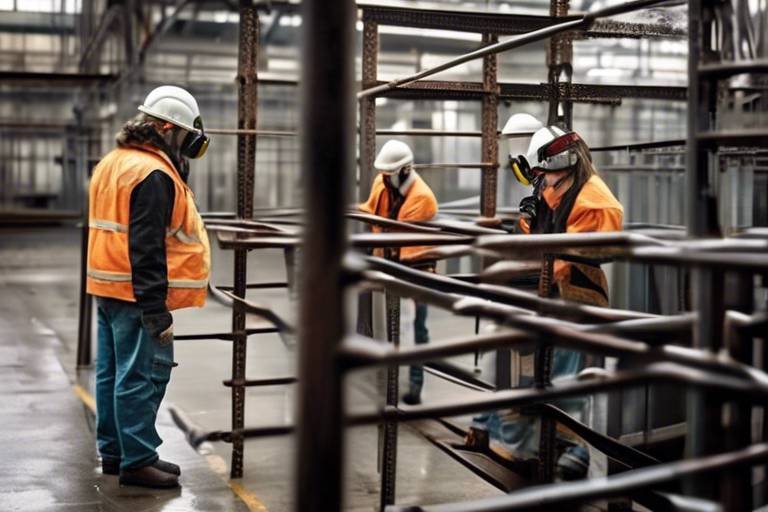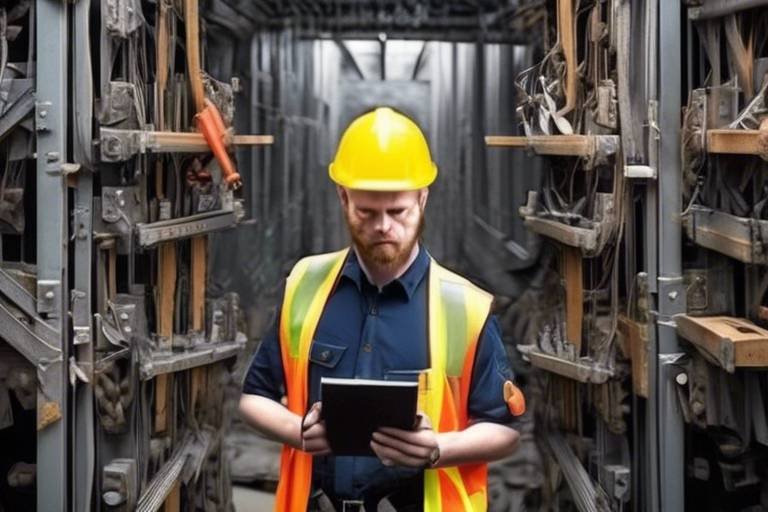Safety at Workplace: The Unavoidable Role of Human Behavior
In today’s fast-paced work environment, the importance of safety cannot be overstated. Yet, despite the best safety protocols and equipment, the human element remains a critical factor in workplace safety. Every day, employees make decisions that can either enhance or undermine safety in their environments. This article dives deep into the intricate relationship between human behavior and workplace safety, emphasizing how individual actions can significantly impact overall safety protocols and organizational culture.
Imagine a workplace where every employee is not only aware of the safety rules but also actively participates in fostering a culture of safety. This is not just a dream; it can be a reality if organizations recognize the role of human behavior in safety practices. When employees feel responsible for their own safety and the safety of their colleagues, the likelihood of accidents decreases dramatically. This leads us to a crucial point: understanding the psychology behind human behavior can be a game changer in creating a safer work environment.
So, what exactly influences our behavior at work? Factors such as stress, fatigue, and even distractions can cloud our judgment and lead to mistakes. For instance, have you ever been so overwhelmed with tasks that you forgot to wear your safety gear? This is a classic example of how human behavior can compromise safety. By recognizing these tendencies, organizations can implement strategies that not only address these issues but also transform them into opportunities for improvement.
Furthermore, the relationship between human behavior and safety is not just about avoiding accidents; it’s about cultivating a culture where safety is prioritized. When employees see their leaders actively engaging in safety initiatives and adhering to protocols, they are more likely to do the same. This creates a ripple effect throughout the organization, promoting a shared responsibility for safety. The bottom line is clear: when individuals take ownership of their actions, the entire workplace benefits.
In summary, the role of human behavior in workplace safety is both significant and unavoidable. By understanding the psychological factors that influence behavior and implementing effective training programs, organizations can create a safety culture that not only reduces incidents but also enhances employee morale. It’s time to take a closer look at how we can all contribute to a safer work environment, starting with our own actions.
A strong safety culture fosters awareness and accountability among employees. Understanding its significance helps organizations create environments where safety is prioritized, leading to reduced incidents and enhanced employee morale. When everyone in the organization believes that safety is a shared responsibility, it becomes a natural part of the daily routine. Employees are more likely to report unsafe conditions and participate in safety training when they feel that their input is valued and taken seriously.
Human errors are a leading cause of workplace accidents. By identifying common mistakes, organizations can implement training and strategies to mitigate risks and enhance overall safety. It’s essential to recognize that errors can happen to anyone; it’s how we respond to these errors that makes the difference. By fostering an environment where mistakes are viewed as learning opportunities rather than failures, organizations can encourage employees to speak up about potential hazards.
Understanding different types of human errors—slips, lapses, and mistakes—can help organizations tailor their safety training programs to address specific areas of concern effectively. Each type of error has its own characteristics and requires different strategies for prevention. For instance, slips and lapses may be addressed through increased awareness and reminders, while decision-making mistakes may necessitate more comprehensive training in critical thinking and risk assessment.
Slips and lapses often occur due to distractions or forgetfulness. Recognizing these behaviors can help in designing interventions that minimize their occurrence and improve workplace safety. Simple measures, such as reminders or checklists, can significantly reduce the likelihood of these errors. Moreover, creating a workspace that minimizes distractions can help employees stay focused and vigilant.
Poor decision-making can lead to dangerous situations. Training employees in critical thinking and risk assessment can enhance their ability to make safer choices in high-pressure environments. For example, role-playing scenarios can help employees practice making quick decisions while considering safety implications. This not only builds confidence but also prepares them for real-life challenges.
Psychological factors, such as stress and fatigue, can significantly impact an individual's ability to adhere to safety protocols. Addressing these factors is crucial for maintaining a safe workplace. Organizations should consider implementing wellness programs that promote mental health and stress management. When employees feel supported and balanced, they are more likely to focus on safety and perform their tasks effectively.
- What is the role of human behavior in workplace safety?
Human behavior plays a crucial role in workplace safety as individual actions can either enhance or compromise safety protocols. - How can organizations improve their safety culture?
Organizations can improve their safety culture by fostering open communication, providing effective training, and encouraging employee involvement in safety initiatives. - What are common human errors that lead to workplace accidents?
Common human errors include slips, lapses, and decision-making mistakes that can occur due to distractions, forgetfulness, or poor judgment.

The Importance of Safety Culture
A strong safety culture is not just a buzzword; it’s the backbone of any organization that values its employees and aims to minimize workplace incidents. When employees feel that safety is a priority, they are more likely to engage in safe practices and hold themselves accountable for their actions. This accountability fosters a sense of community and responsibility, where everyone looks out for one another. Imagine a workplace where everyone is vigilant about safety—this is what a robust safety culture can achieve.
Understanding the significance of safety culture is crucial for organizations aiming to create environments where safety is prioritized. A positive safety culture can lead to reduced incidents and enhanced employee morale. Employees who perceive their workplace as safe are more likely to be productive and satisfied with their jobs. This not only improves retention rates but also contributes to a more harmonious work environment.
Moreover, a strong safety culture encourages employees to speak up about potential hazards without fear of retribution. When workers feel safe to express their concerns, it leads to quicker identification of risks and more effective mitigation strategies. Here are some key elements that contribute to a strong safety culture:
- Leadership Commitment: Leaders must actively promote safety and integrate it into the organizational values.
- Employee Engagement: Involving employees in safety discussions and decision-making fosters ownership and accountability.
- Continuous Improvement: Regularly evaluating safety protocols and seeking feedback helps organizations adapt and improve.
In essence, a strong safety culture is like a well-oiled machine. Each part—leadership, employee engagement, and continuous improvement—works together to create a seamless operation. When all components function effectively, the result is a workplace where safety is not just an obligation but a shared value. This is the kind of environment that attracts top talent and retains skilled employees, ultimately leading to greater success for the organization.
In conclusion, investing in a strong safety culture is not merely a compliance issue; it’s a strategic approach that can enhance overall organizational performance. By prioritizing safety, organizations can cultivate a positive atmosphere that benefits everyone involved. So, let’s take that first step toward a safer workplace—because at the end of the day, safety is everyone’s responsibility.
Q: What is a safety culture?
A: A safety culture refers to the shared values, beliefs, and behaviors regarding safety within an organization. It emphasizes the importance of safety and encourages employees to prioritize it in their daily activities.
Q: How can we improve our safety culture?
A: Improving safety culture involves leadership commitment, employee engagement, continuous training, and open communication about safety concerns.
Q: Why is employee engagement important in safety culture?
A: Engaging employees in safety initiatives fosters ownership and accountability, leading to a more proactive approach to identifying and mitigating risks.
Q: Can a strong safety culture impact productivity?
A: Yes, a strong safety culture can enhance productivity by creating a work environment where employees feel safe and valued, leading to higher job satisfaction and lower turnover rates.

Common Human Errors in the Workplace
When we think about workplace safety, it’s easy to focus on policies, equipment, and protocols. However, the most significant factor often lies within us—our human behavior. It's mind-boggling to realize that a simple mistake, like forgetting to wear protective gear or misjudging a situation, can lead to serious accidents. Understanding common human errors is crucial for organizations aiming to enhance their safety protocols. By identifying these errors, businesses can implement effective training and strategies to minimize risks.
One of the standout issues in workplace safety is the prevalence of human error. In fact, studies suggest that over 70% of workplace incidents are attributed to human mistakes. These errors can be categorized into three main types: slips, lapses, and mistakes. Each type has its own characteristics and implications for safety practices. For instance, slips often occur during routine tasks when our minds wander, while lapses are more about forgetfulness—like leaving tools scattered around a worksite.
To give you a clearer picture, let’s briefly discuss these types:
- Slips: These are unintended actions that can happen even to the most experienced workers. Imagine a seasoned technician who accidentally drops a tool because they were distracted by a conversation. This can lead to injuries not just for them but also for nearby colleagues.
- Lapses: These occur when someone forgets to perform a task, like not locking out equipment during maintenance. It’s like forgetting to turn off the stove; it’s a simple lapse that can have disastrous consequences.
- Decision-Making Mistakes: These happen when an employee makes a poor choice due to lack of information or pressure. Imagine a worker rushing to complete a task and deciding to skip safety checks—this can lead to catastrophic outcomes.
Recognizing these human errors is just the first step. Organizations need to create a culture where employees feel comfortable acknowledging their mistakes without fear of retribution. This approach not only promotes honesty but also fosters a proactive safety environment. After all, if employees can openly discuss errors, it becomes easier to find solutions and prevent future incidents.
Moreover, regular training sessions focusing on these common errors can significantly improve workplace safety. By educating employees about the types of errors and how to avoid them, organizations can empower their workforce to take responsibility for their actions. Think of it as teaching someone to ride a bike; they need to understand the mechanics and be aware of their surroundings to avoid falling.
In conclusion, addressing common human errors in the workplace is not just about enforcing rules; it’s about understanding the intricate relationship between human behavior and safety. By fostering an environment that prioritizes awareness and accountability, organizations can significantly reduce the risk of accidents and enhance overall safety culture.
Q: What are the most common types of human errors in the workplace?
A: The most common types of human errors include slips, lapses, and decision-making mistakes. Each type can lead to safety incidents if not properly addressed.
Q: How can organizations reduce human errors?
A: Organizations can reduce human errors by implementing effective training programs, promoting a culture of safety, and encouraging open communication among employees.
Q: Why is it important to address human behavior in safety protocols?
A: Addressing human behavior is crucial because a significant number of workplace incidents stem from human errors. By understanding and mitigating these errors, organizations can enhance safety and reduce accidents.

Types of Human Errors
Understanding the that occur in the workplace is crucial for developing effective safety strategies. Human errors can generally be categorized into three main types: slips, lapses, and mistakes. Each of these errors has its own characteristics and triggers, which can help organizations pinpoint areas for improvement in safety training and protocols.
Slips are unintentional actions that occur when a person intends to do one thing but accidentally does another. For example, an employee might mean to pick up a tool but instead grabs the wrong one due to momentary distraction. Lapses, on the other hand, are related to memory failures. These happen when an individual forgets to complete a task or steps in a process, such as forgetting to wear safety gear before starting a job. Both slips and lapses are often influenced by external factors, such as noise, fatigue, or multitasking, which can lead to a decrease in focus.
In contrast, decision-making mistakes arise from poor judgment or inadequate knowledge. For instance, an employee might decide to bypass a safety protocol because they believe it will save time, not realizing the potential risks involved. This type of error can be particularly dangerous, as it often stems from a misunderstanding of the situation or a lack of proper training.
To illustrate these types of human errors, here’s a quick comparison:
| Error Type | Description | Example |
|---|---|---|
| Slips | Unintentional actions caused by distraction. | Grabbing the wrong tool. |
| Lapses | Memory failures leading to incomplete tasks. | Forgetting to wear safety gear. |
| Mistakes | Poor judgment or inadequate knowledge. | Bypassing safety protocols to save time. |
By recognizing these types of errors, organizations can tailor their safety training programs to address specific concerns effectively. For example, if slips and lapses are common, companies might implement strategies to reduce distractions and remind employees of their responsibilities. On the other hand, if decision-making mistakes are prevalent, enhancing critical thinking skills through targeted training could be the solution.
Ultimately, understanding the nuances of human errors not only helps in enhancing workplace safety but also contributes to a more informed and responsible workforce. By fostering an environment where employees are aware of the potential for human error, organizations can create a culture of safety that prioritizes vigilance and accountability.
- What are the main types of human errors? The main types include slips, lapses, and mistakes.
- How can organizations reduce human errors? By providing targeted training, minimizing distractions, and fostering a culture of safety.
- What role does leadership play in reducing human errors? Leaders can model safe behaviors and encourage open communication about safety concerns.

Slips and Lapses
Slips and lapses are two common types of human errors that can lead to unfortunate accidents in the workplace. Imagine you're juggling multiple tasks—your mind is racing, and suddenly, you forget to follow a crucial safety protocol. This scenario is all too familiar for many employees. Slips often occur when we perform routine tasks and get distracted, while lapses are more about forgetfulness during critical moments. Both can have serious consequences, making it essential to address these behaviors head-on.
To effectively reduce slips and lapses, organizations can implement several strategies. For instance, creating a distraction-free environment can significantly minimize the chances of errors. This could involve:
- Designating quiet zones for high-concentration tasks
- Utilizing reminders and checklists to keep safety protocols top of mind
- Encouraging employees to take regular breaks to refresh their focus
Moreover, training programs that emphasize situational awareness can help employees remain vigilant. By fostering a mindset where team members are aware of their surroundings, organizations can reduce the likelihood of slips during routine operations. For example, role-playing scenarios during training sessions can provide practical experience in recognizing and addressing potential distractions.
Additionally, it's crucial to create an environment where employees feel comfortable admitting their mistakes. When individuals can openly discuss their lapses without fear of punishment, it paves the way for learning and improvement. Organizations can establish anonymous reporting systems or regular safety meetings to facilitate this open dialogue.
In summary, slips and lapses are not just minor inconveniences; they can lead to severe safety incidents. By understanding these behaviors and implementing effective strategies, organizations can significantly enhance workplace safety. Remember, a culture that prioritizes safety awareness is a culture that protects its employees.
What are slips and lapses?
Slips are errors that occur during routine tasks, often due to distractions, while lapses are forgetfulness that can lead to missed safety protocols.
How can organizations reduce slips and lapses?
Organizations can reduce slips and lapses by creating distraction-free environments, utilizing reminders, and fostering open communication about safety concerns.
Why is it important to address slips and lapses?
Addressing slips and lapses is crucial because they can lead to serious accidents. A proactive approach can help cultivate a safer workplace culture.

Decision-Making Mistakes
When it comes to workplace safety, can have dire consequences. These errors often stem from a lack of information, inadequate training, or even the pressure of tight deadlines. Imagine you're at a construction site, and you have to decide whether to remove a safety barrier to speed up the process. In that moment, the decision might seem harmless, but the repercussions could be catastrophic. This scenario highlights how crucial it is for employees to be equipped with the right tools and knowledge to make informed choices.
One of the significant factors contributing to decision-making mistakes is cognitive overload. When employees are overwhelmed with information or tasks, their ability to think critically diminishes. This can lead to snap judgments that overlook safety protocols. For instance, an employee might skip safety checks because they feel rushed, thinking, "I’ll just do it this one time." However, this one-time decision can lead to serious accidents.
To combat this, organizations should focus on training programs that emphasize critical thinking and risk assessment. By simulating high-pressure situations, employees can practice making decisions in a controlled environment. This not only boosts their confidence but also prepares them to handle real-life scenarios more effectively. Moreover, creating a culture where employees feel comfortable asking questions or seeking clarification can significantly reduce the risk of poor decision-making.
Here are a few strategies organizations can implement to minimize decision-making mistakes:
- Regular Training Sessions: Conduct workshops that focus on decision-making processes and the importance of adhering to safety protocols.
- Scenario-Based Learning: Use real-life scenarios to help employees practice making decisions while considering safety implications.
- Encourage Team Discussions: Foster an environment where team members can discuss safety concerns and decision-making strategies openly.
Ultimately, the goal is to empower employees with the knowledge and confidence they need to make safe decisions. By understanding the potential pitfalls of decision-making and implementing effective training methods, organizations can greatly enhance workplace safety and reduce the likelihood of accidents caused by human error.
Q: What are some common decision-making mistakes in the workplace?
A: Common mistakes include rushing decisions, ignoring safety protocols, and failing to seek input from others. These can lead to accidents and unsafe working conditions.
Q: How can organizations improve decision-making among employees?
A: Organizations can improve decision-making by providing regular training, fostering open communication, and creating a supportive environment where employees feel comfortable discussing safety concerns.
Q: Why is critical thinking important for workplace safety?
A: Critical thinking allows employees to analyze situations, weigh risks, and make informed decisions that prioritize safety, ultimately reducing the likelihood of accidents.

Psychological Factors in Safety
When we think about workplace safety, we often focus on physical hazards, equipment, and protocols. However, psychological factors play a pivotal role in ensuring a safe work environment. Stress, fatigue, and mental health issues can significantly impair an individual's ability to adhere to safety protocols. Imagine trying to navigate a busy street while your mind is racing with worries—this is akin to how employees may operate under pressure at work. Their focus is divided, and the likelihood of making mistakes increases.
For instance, consider a factory setting where employees are under constant pressure to meet deadlines. The stress of achieving targets can lead to a state of mental fatigue, which diminishes their attention to safety measures. When individuals are overwhelmed, they may overlook critical safety checks or fail to use protective equipment properly. This not only endangers their lives but also puts their colleagues at risk. Therefore, recognizing and addressing these psychological factors is essential for cultivating a safe workplace.
Moreover, the impact of fatigue cannot be underestimated. Long working hours or insufficient breaks can lead to decreased alertness. A tired worker is more likely to experience slips and lapses, which are common causes of accidents. For example, a worker who is fatigued may forget to secure a safety harness before climbing a ladder, leading to potentially catastrophic consequences. Addressing fatigue through proper scheduling and encouraging breaks can significantly enhance safety outcomes.
Another critical aspect is the influence of mental health on workplace safety. Employees struggling with mental health issues may find it challenging to concentrate or follow safety protocols. Organizations should foster an environment where mental health is openly discussed and supported. Providing access to counseling services and promoting a work-life balance can alleviate stress and enhance overall well-being, ultimately leading to a safer workplace.
To effectively manage these psychological factors, companies can implement the following strategies:
- Regular Mental Health Assessments: Conducting assessments can help identify employees who may be struggling and provide them with the necessary support.
- Stress Management Programs: Offering workshops on stress management techniques can equip employees with tools to handle workplace pressures.
- Encouraging Breaks: Implementing policies that encourage regular breaks can help reduce fatigue and improve focus.
In conclusion, understanding the psychological factors at play in workplace safety is crucial. By addressing stress, fatigue, and mental health, organizations can create a more secure environment for their employees. After all, a safe workplace is not just about physical safety; it’s about ensuring that every employee feels mentally equipped to perform their tasks safely.
Q: How can stress impact workplace safety?
A: Stress can lead to distractions and impaired judgment, increasing the likelihood of accidents and errors in safety protocols.
Q: What are some signs of fatigue in employees?
A: Signs can include decreased alertness, frequent yawning, difficulty concentrating, and increased irritability.
Q: How can organizations support mental health in the workplace?
A: Organizations can provide access to mental health resources, promote open discussions about mental health, and create a supportive work environment.

Training and Education Programs
In today's fast-paced work environment, effective training and education programs are not just optional; they are essential for ensuring workplace safety. These programs serve as the backbone of an organization's safety culture, equipping employees with the necessary skills and knowledge to navigate potential hazards. When tailored appropriately, training can significantly influence human behavior, leading to a more conscientious approach to safety protocols.
One of the key aspects of designing an effective training program is to ensure it is engaging and relevant. Employees are more likely to absorb information and apply it when they see its direct relevance to their daily tasks. This means that the training should not only cover theoretical knowledge but also include practical applications that mimic real-life scenarios. For instance, incorporating role-playing exercises or simulation drills can help employees visualize the consequences of unsafe practices, making the training experience more impactful.
Moreover, behavioral-based safety training has emerged as a highly effective approach. This method emphasizes observation and feedback, allowing employees to learn from each other’s experiences. By creating a culture of peer learning, organizations can foster a sense of accountability where every employee feels responsible for their own safety and that of their colleagues. This not only enhances compliance with safety protocols but also builds a community that values safety as a shared goal.
Another important element is the need for ongoing education and refresher courses. Safety protocols are not static; they evolve as new technologies and methodologies emerge. Regularly scheduled training sessions ensure that employees stay informed about the latest safety practices and any changes in organizational policies. This continuous learning approach not only reinforces the importance of safety but also keeps employees engaged and aware of their surroundings.
| Type of Training | Description | Frequency |
|---|---|---|
| Initial Safety Training | Comprehensive introduction to safety protocols and procedures. | Upon hiring |
| Behavioral-Based Safety Training | Focuses on changing unsafe behaviors through observation and feedback. | Quarterly |
| Refresher Courses | Updates on new safety practices and reinforces existing knowledge. | Annually |
In summary, the goal of training and education programs is to cultivate a workforce that is not only aware of safety protocols but also actively participates in creating a safe working environment. By investing in high-quality training and fostering an atmosphere of continuous learning, organizations can significantly reduce workplace accidents and enhance employee morale. After all, a well-trained employee is not just an asset; they are a vital part of a safe and thriving workplace.
- What is the purpose of safety training? Safety training aims to educate employees about potential hazards and how to mitigate risks effectively.
- How often should safety training be conducted? It is recommended to conduct initial training upon hiring and refresher courses at least annually, with ongoing training as needed.
- What is behavioral-based safety training? This training focuses on changing employee behaviors through observation and feedback, promoting a culture of safety.
- Why is ongoing education important? Ongoing education ensures employees are up-to-date with the latest safety protocols and practices, adapting to changes in the workplace.

Behavioral-Based Safety Training
Behavioral-Based Safety Training (BBST) is an innovative approach that focuses on altering employee behavior through observation and feedback. This method recognizes that the majority of workplace accidents stem from human behavior rather than mechanical failures or environmental hazards. By addressing the root causes of unsafe behaviors, organizations can cultivate a culture of safety that permeates every level of the workforce. Imagine a workplace where safety becomes second nature, where employees instinctively choose the safest option because they have been trained to recognize and correct risky behaviors.
At the heart of BBST is the concept of observation. Employees are encouraged to observe their peers and themselves, identifying unsafe practices and providing constructive feedback. This peer-to-peer interaction fosters a sense of accountability and encourages open dialogue about safety concerns. For instance, if an employee notices a colleague not wearing protective gear, they can gently remind them of the safety protocols. This not only corrects the behavior but also strengthens the team’s commitment to safety.
Moreover, BBST promotes a proactive approach to safety. Instead of waiting for accidents to happen, organizations implementing this training actively seek to identify and mitigate risks before they lead to incidents. This involves regular safety audits, where employees can report unsafe conditions or behaviors without fear of retribution. The goal is to create an environment where safety is everyone’s responsibility, and individuals feel empowered to contribute to a safer workplace.
To effectively implement BBST, organizations should consider the following components:
- Training Sessions: Regularly scheduled training sessions that focus on identifying unsafe behaviors and developing corrective actions.
- Feedback Mechanisms: Establishing systems for providing feedback on observed behaviors, such as one-on-one discussions or team meetings.
- Recognition Programs: Recognizing and rewarding employees who demonstrate safe behaviors can motivate others to follow suit.
In addition, BBST can be tailored to fit the specific needs of different industries. For example, in a manufacturing setting, training might focus on the proper use of machinery and personal protective equipment (PPE), while in an office environment, it could emphasize ergonomic practices and safe workstation setups. This customization ensures that the training is relevant and applicable, which enhances its effectiveness.
Ultimately, the success of Behavioral-Based Safety Training hinges on leadership commitment. Leaders must not only endorse the program but also actively participate in it. When employees see their supervisors engaging in safety practices and valuing their input, it reinforces the importance of safety across the organization. This alignment between leadership and employees creates a unified front in the quest for a safer workplace.
1. What is Behavioral-Based Safety Training?
Behavioral-Based Safety Training is a proactive approach aimed at changing unsafe behaviors in the workplace through observation, feedback, and accountability.
2. How does BBST differ from traditional safety training?
Unlike traditional training that often focuses on rules and regulations, BBST emphasizes changing behaviors and creating a culture of safety through peer interactions and ongoing feedback.
3. Can BBST be applied in any industry?
Yes, BBST can be tailored to fit the specific needs of various industries, making it applicable in settings ranging from construction to office environments.
4. What role do leaders play in BBST?
Leaders are crucial in modeling safe behaviors, engaging with employees, and fostering an environment where safety is prioritized and valued.

Ongoing Education and Refreshers
In today's fast-paced work environment, are not just beneficial; they are essential for maintaining a robust safety culture. Imagine a ship sailing through turbulent waters; without constant adjustments and updates to its navigation system, it risks veering off course. Similarly, employees must regularly update their safety knowledge to navigate the complexities of their roles effectively. This is where ongoing education comes into play, ensuring that safety protocols remain fresh in the minds of all team members.
Regular safety refreshers serve multiple purposes. First and foremost, they help reinforce the importance of safety protocols that might otherwise fade from memory over time. Just like how athletes practice their skills continuously to stay in top form, employees need to engage in regular training sessions to keep safety at the forefront of their minds. These sessions can take various forms, including workshops, online courses, and hands-on training exercises, each tailored to fit the unique needs of the organization.
Moreover, ongoing education is vital for adapting to changes in regulations, technology, and workplace conditions. For instance, if new machinery is introduced, employees must be educated on its safe operation and potential hazards. A well-structured refresher program can include:
- Updates on new safety regulations
- Training on new equipment or procedures
- Review of past incidents to learn from mistakes
Additionally, these refresher courses can enhance employee engagement and morale. When employees see that their organization is committed to their safety and well-being, they are more likely to feel valued and motivated. This creates a positive feedback loop where employees actively participate in safety initiatives, share their concerns, and contribute to a culture of safety. To sum it up, ongoing education and refreshers are not just about compliance; they are about creating a workplace where safety is a shared value and responsibility.
Q1: Why is ongoing education important for workplace safety?
A1: Ongoing education is crucial because it keeps safety protocols fresh in employees' minds, helps them adapt to new regulations and technologies, and reinforces a culture of safety within the organization.
Q2: What types of training can be included in ongoing education?
A2: Training can include workshops, online courses, hands-on exercises, and updates on new safety regulations or equipment. It's essential to tailor the training to the specific needs of the organization.
Q3: How often should safety refreshers be conducted?
A3: The frequency of safety refreshers can vary based on the industry, but conducting them at least annually, or whenever there is a significant change in equipment or procedures, is generally recommended.
Q4: How can ongoing education improve employee morale?
A4: When employees see that their organization prioritizes their safety through ongoing education, they feel valued and more engaged in their work, which enhances overall morale.

The Role of Leadership in Safety
Leadership is not just about managing tasks; it's about creating an environment where safety is a fundamental value. When leaders prioritize safety, they set the tone for the entire organization. Imagine walking into a workplace where the atmosphere is charged with a commitment to safety—this is the kind of environment that effective leadership can cultivate. By actively engaging with safety initiatives and demonstrating safe practices, leaders inspire their teams to adopt similar behaviors. This ripple effect can significantly enhance the overall safety culture within the organization.
One of the key responsibilities of leaders is to model safe behaviors. When employees see their leaders adhering to safety protocols, it reinforces the message that safety is a shared responsibility. For instance, if a manager consistently wears personal protective equipment (PPE) and follows safety procedures, employees are more likely to do the same. This concept of leading by example is crucial because it establishes a standard that everyone in the organization is expected to follow.
Additionally, encouraging open communication about safety concerns is another vital aspect of leadership. When employees feel comfortable voicing their safety concerns without fear of retribution, it fosters a culture of transparency. This openness not only helps identify potential hazards early but also empowers employees to take an active role in their own safety. For example, a simple suggestion box or regular safety meetings can provide platforms for employees to express their thoughts. Leaders should actively solicit feedback and demonstrate that they value employee input.
To illustrate the impact of leadership on workplace safety, consider the following table that outlines the key roles leaders play in promoting a safe work environment:
| Leadership Role | Description |
|---|---|
| Modeling Safe Behaviors | Leaders demonstrate adherence to safety protocols, encouraging employees to follow suit. |
| Encouraging Open Communication | Creating a safe space for employees to voice concerns and suggestions about safety. |
| Providing Resources and Training | Ensuring employees have access to necessary safety resources and training programs. |
| Recognizing and Rewarding Safe Practices | Celebrating employees who exemplify safe behaviors to reinforce positive actions. |
It's also important for leaders to provide the necessary resources and training to ensure that employees are well-equipped to maintain safety standards. This includes not just physical resources but also ongoing education to keep safety protocols fresh in everyone's mind. Regular training sessions and workshops can significantly enhance employees' understanding of safety measures, making them more likely to adhere to them in their daily tasks.
Lastly, recognizing and rewarding safe practices can serve as a powerful motivator. When employees are acknowledged for their commitment to safety, it reinforces the importance of these behaviors and encourages others to follow suit. This kind of positive reinforcement helps to solidify safety as a core value within the organization.
In conclusion, the role of leadership in workplace safety cannot be overstated. By modeling safe behaviors, encouraging open communication, providing necessary resources, and recognizing safe practices, leaders can create a robust safety culture that not only protects employees but also enhances overall organizational performance.
Q: How can leaders effectively communicate safety protocols to their teams?
A: Leaders can effectively communicate safety protocols through regular meetings, training sessions, and by utilizing visual aids such as posters and handouts. Open discussions and feedback sessions also encourage understanding and compliance.
Q: What are some ways to encourage employee participation in safety initiatives?
A: Encouraging participation can be achieved by involving employees in safety committees, soliciting their input on safety practices, and recognizing their contributions to safety improvements.
Q: How often should safety training be conducted?
A: Safety training should be conducted regularly, with refresher courses at least annually or whenever new safety protocols are introduced. Frequent training helps reinforce safety practices and keeps them top of mind for employees.

Leading by Example
When it comes to workplace safety, leadership is not just about making rules; it's about embodying the principles of safety in every action and decision. Leaders who prioritize safety and demonstrate safe practices create an environment where employees feel empowered to do the same. Imagine a ship sailing through stormy waters—if the captain is calm and follows safety protocols, the crew is more likely to remain focused and act responsibly. In the same way, leaders who lead by example set a tone for the entire organization.
But what does it really mean to lead by example in the context of safety? It involves a few key behaviors:
- Modeling Safe Practices: Leaders should actively participate in safety training sessions and adhere to safety protocols themselves. When employees see their leaders wearing protective gear, following procedures, and prioritizing safety, they are more likely to adopt these behaviors.
- Engaging in Safety Initiatives: Leaders should not only endorse safety programs but also take part in them. This could mean joining safety audits, participating in safety drills, or being involved in safety committees. Their presence reinforces the importance of safety.
- Providing Constructive Feedback: When leaders observe unsafe practices, addressing them promptly and constructively is crucial. This not only corrects the behavior but also shows that safety is a priority for the organization.
Moreover, a leader's attitude towards safety can significantly influence the organization's culture. If leaders treat safety as a mere checkbox in compliance with regulations, employees may view it similarly. On the other hand, when safety is integrated into the core values of the organization, it becomes a shared responsibility. This shift can lead to a more proactive approach where employees feel responsible for not just their own safety but also that of their colleagues.
In conclusion, leading by example is not just a strategy; it's a fundamental principle that can transform workplace safety culture. When leaders actively demonstrate their commitment to safety, they inspire others to do the same, creating a ripple effect that enhances overall safety and well-being in the workplace.
- Why is leading by example important for workplace safety? Leading by example is crucial because it sets a standard for employees to follow. When leaders prioritize safety, employees are more likely to adopt those behaviors.
- How can leaders demonstrate their commitment to safety? Leaders can demonstrate commitment by participating in safety training, consistently following safety protocols, and engaging in safety initiatives.
- What impact does leadership have on safety culture? Leadership significantly influences safety culture. A positive attitude towards safety from leaders fosters an environment where employees feel responsible for maintaining safety standards.

Encouraging Open Communication
When it comes to workplace safety, one of the most vital yet often overlooked components is open communication. Imagine a workplace where every employee feels empowered to voice their concerns about safety without the fear of judgment or retribution. This kind of environment not only enhances safety protocols but also cultivates a culture of trust and collaboration. But how do we foster this open communication? It starts with leadership setting the tone.
Leaders play a crucial role in shaping how communication flows within the organization. When they prioritize safety and openly discuss it, employees are more likely to follow suit. For instance, holding regular safety meetings where everyone is encouraged to share their thoughts can significantly improve the dialogue surrounding safety issues. This practice not only identifies potential hazards but also allows for the sharing of best practices among team members.
Moreover, creating anonymous channels for reporting safety concerns can be a game-changer. Employees who might hesitate to speak up in a public forum may feel more comfortable sharing their thoughts anonymously. This can be achieved through suggestion boxes, anonymous surveys, or dedicated online platforms. The key is to ensure that employees know their voices are heard and valued.
It's also essential to provide feedback on the concerns raised. When employees see that their input leads to tangible changes or improvements, it reinforces the idea that open communication is not just welcomed but necessary. For example, if a worker suggests a new safety protocol, and that suggestion is implemented, acknowledging their contribution can motivate others to share their insights as well.
To further enhance this communication culture, organizations can implement training sessions focused on effective communication strategies. Employees can learn how to express their concerns clearly and constructively, making it easier for everyone to engage in meaningful discussions about safety. Remember, a culture of safety is built on the foundation of open dialogue.
In summary, encouraging open communication about safety is not merely a checkbox in a compliance list; it's a fundamental aspect of creating a safe workplace. By fostering an environment where employees feel comfortable sharing their thoughts and concerns, organizations can significantly reduce risks and enhance overall safety. The dialogue must be continuous, and the commitment to safety should be unwavering.
- Why is open communication important for workplace safety?
Open communication allows employees to express concerns, share best practices, and contribute to a safer work environment. - How can leaders promote open communication?
Leaders can promote open communication by modeling safe behaviors, encouraging feedback, and facilitating regular discussions on safety. - What are some ways to gather anonymous feedback?
Organizations can use suggestion boxes, anonymous surveys, or dedicated online platforms to gather feedback without fear of retribution. - How can training improve communication about safety?
Training can equip employees with the skills to express their concerns clearly and constructively, leading to more effective discussions about safety.
Frequently Asked Questions
- What is the importance of safety culture in the workplace?
A strong safety culture is essential as it fosters awareness and accountability among employees. When safety is prioritized, it leads to fewer incidents and boosts employee morale. Think of it as the backbone of a healthy work environment; without it, everything else can crumble.
- What are common human errors that lead to workplace accidents?
Common human errors include slips, lapses, and poor decision-making. These errors often stem from distractions or forgetfulness. By identifying these mistakes, organizations can implement targeted training to minimize risks and enhance safety.
- How can psychological factors impact workplace safety?
Psychological factors like stress and fatigue can significantly hinder an individual's ability to adhere to safety protocols. Addressing these issues is crucial for maintaining a safe workplace, as a well-rested and mentally healthy employee is more likely to follow safety measures.
- What role does training play in enhancing workplace safety?
Effective training and education programs are vital for shaping employee behavior regarding safety. Tailored programs that focus on behavioral changes can lead to better compliance and reduced accidents. Regular refreshers keep safety at the forefront of employees' minds.
- How can leadership influence workplace safety?
Leadership plays a pivotal role in promoting safety. Leaders must model safe behaviors and engage employees in safety initiatives. By leading by example, they set a standard that encourages everyone to take safety seriously.
- What is behavioral-based safety training?
Behavioral-based safety training focuses on changing employee behavior through observation and feedback. This proactive approach helps cultivate a culture of safety within the organization, making safety a shared responsibility among all employees.
- Why is open communication about safety concerns important?
Open communication allows employees to voice safety concerns without fear, leading to quicker resolutions and a more proactive approach to workplace safety. When employees feel heard, they are more likely to engage in safety practices actively.


















